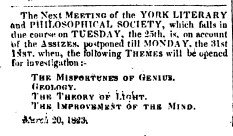Two hundred years ago …
Friday 29th April 2022
Meanwhile in Yorkshire …
The Rev. George Bird and his artist John Bird were hard at work on A Geological Survey of the Yorkshire Coast … (&c – all 19th century geological texts need to be abbreviated!), containing a full chapter on the Kirkdale discoveries. Remarkably, this achieved publication within the year. And the Rev. William Eastmead’s history of Ryedale, Historia Rievallensis … (&c), was not far behind, with its own account of Kirkdale.
Otherwise Yorkshire saw little overt Kirkdale-related action: although it is likely that the locally-flourishing trade in fake Kirkdale fossils continued to supply the needs of the less discriminating collector.
The future founders of the Yorkshire Philosophical Society – William Salmond, Anthony Thorpe, and James Atkinson – have left few traces of their activity in the Spring of 1822. Inevitably, they will have been discussing Kirkdale matters, possibly even the question of depositing fossils in some form of a museum, or even forming a learned society. More, perhaps, in the next Two Hundred Years Ago. The Rev. William Venables Vernon (aka William Vernon Harcourt) was no doubt aware of developments, corresponding with William Buckland, and continuing with his chemical experiments in his Bishopthorpe laboratory (whether or not these included album graecum from Kirkdale).
Ironically, there was one man in York who had experience of collecting fossils and founding museums and learned societies, but was unable to mention this: Philip Francis Sidney, editor of the Yorkshire Observer. Sidney arrived in York some time around 1820. He first appears, anonymously, in the Yorkshire Gazette, writing a series of essays on various aspects of life in York, under the nom de plume of ‘The Hermit of St Mary’. In 1822 the first edition of The Yorkshire Observer appeared, with Sidney as proprietor, editor, and (probably) sole  writer. The Hermit moved to his new home, continuing the (numbered) sequence of essays started in the Gazette. In the course of 1822, Sidney commented on the Kirkdale finds and – slightly later – claimed that a York Literary and Philosophical Society had actually come into existence, and was undertaking various scientific discussions – all of which seems to have gone un-noticed by the York Herald, the Yorkshire Gazette or, indeed, the people of York at large. Then, when the Yorkshire Philosophical Society actually formed, he criticised it for being too aristocratic and undemocratic (fair comment?), before concluding that it was, on the whole, probably A Good Thing.
writer. The Hermit moved to his new home, continuing the (numbered) sequence of essays started in the Gazette. In the course of 1822, Sidney commented on the Kirkdale finds and – slightly later – claimed that a York Literary and Philosophical Society had actually come into existence, and was undertaking various scientific discussions – all of which seems to have gone un-noticed by the York Herald, the Yorkshire Gazette or, indeed, the people of York at large. Then, when the Yorkshire Philosophical Society actually formed, he criticised it for being too aristocratic and undemocratic (fair comment?), before concluding that it was, on the whole, probably A Good Thing.
Finally, in June 1823 the Yorkshire Observer abruptly ceased publication and Sidney disappeared, leaving his financial affairs for an agent to disentangle.
Which, almost certainly, was impossible to achieve, since Philip Francis Sidney did not actually exist. There is no trace of him having been born, or died. No Census record. Nothing, either before or after his time in York.
He was in fact an Irish adventurer, Thomas Ashe. Before coming to York, Ashe had a rather varied career, including duels, fighting as a soldier of fortune in various continental wars, capture by the French and escape, smuggling diamonds from a Brazilian Imperial diamond mine while masquerading as an emissary of King George  IV, editing a newspaper for Thomas Jefferson, fighting off marauding Indians … and, in passing, embezzling a collection of fossil mammoth bones, intending them for a museum. He also published the first novel set in the Isle of Man, travel books on various countries – several of which he had actually been to – and three volumes of his memoirs, up to 1815 (much of which is actually true). His career after leaving York included editing a Manx newspaper, setting up a Museum (or, possibly, two), insolvency and incarceration, writing political pamphlets, threatening to kill the Duke Of Cumberland, blackmail, and an Old Bailey trial in which Irish charm seems to have outweighed forensic evidence, resulting in an improbable acquittal (which greatly upset the Duke of Cumberland).
IV, editing a newspaper for Thomas Jefferson, fighting off marauding Indians … and, in passing, embezzling a collection of fossil mammoth bones, intending them for a museum. He also published the first novel set in the Isle of Man, travel books on various countries – several of which he had actually been to – and three volumes of his memoirs, up to 1815 (much of which is actually true). His career after leaving York included editing a Manx newspaper, setting up a Museum (or, possibly, two), insolvency and incarceration, writing political pamphlets, threatening to kill the Duke Of Cumberland, blackmail, and an Old Bailey trial in which Irish charm seems to have outweighed forensic evidence, resulting in an improbable acquittal (which greatly upset the Duke of Cumberland).
Sadly, Philip Francis Sidney is almost completely irrelevant to the Kirkdale story. And Thomas Ashe even more so. But I do find both of them irresistible, and may find an excuse to bring them into the story again …
Peter Hogarth
Illustrations: Yorkshire Observer 8 March 1823 (above) & Yorkshire Observer 22 March 1823 (below)
